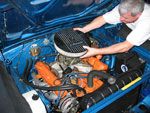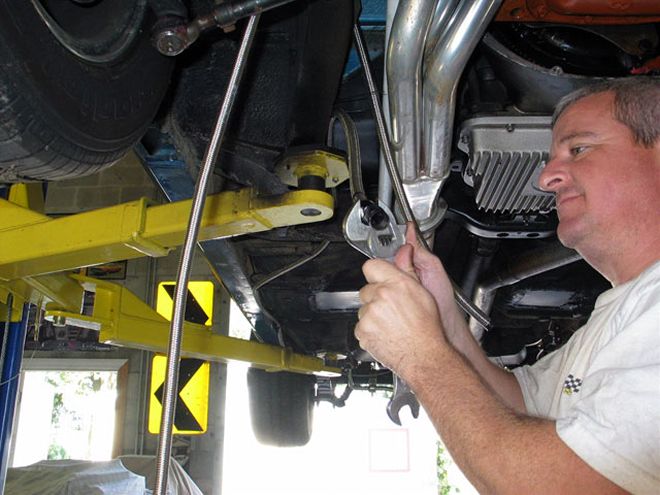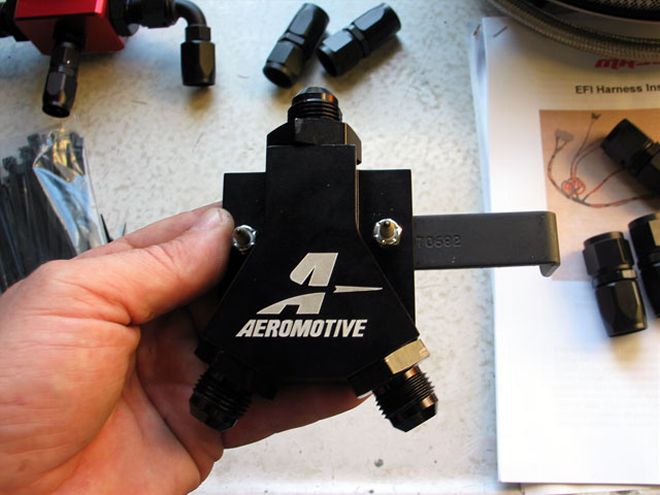
Electronic fuel injection. These three words can strike fear in even the most seasoned automotive technician. The reality, however, is that no carbureted induction system can match the fuel-metering accuracy of electronic fuel injection. The reason is simple, fuel injection is interactive and a carburetor is not. Once a carburetor is adjusted, the tuning can't be changed while driving to accommodate varying weather conditions and driving habits. This is what gives electronic fuel injection a huge advantage. By monitoring engine parameters, such as coolant temperature, throttle position, manifold air pressure, air flow through the engine, and the mixture of the spent gasses, fuel injection can actually adapt to changing conditions as the car is driving, always ensuring the proper fuel/air mixture no matter what the circumstances. Therefore, even the most sophisticated performance carburetors can't match the fuel metering accuracy of fuel injection.
Benefits of electronic fuel injection are many. Throttle response can be vastly improved as can all-around drivability. No more pumping the gas or setting the choke for cold starts either. Since most fuel-injection systems monitor the temperature of both the ambient air and the engine's coolant, it takes care of enriching the fuel/air mixture automatically for cold starts. Also, since fuel-injection systems require a higher fuel pressure and continuously return a portion of fuel to the tank, fuel starvation, or "vapor lock," is also a thing of the past. An additional advantage of fuel injection is an improvement in fuel economy. Because most carburetors only have two or three tunable circuits, they generally tend to run a little rich during certain driving conditions and waste fuel in the process. Since fuel injection is an interactive system, it can provide the engine with an ideal mixture of fuel and air during all phases of driving, thereby using less fuel than the typical carbureted engine. So with all these advantages, why aren't more people converting their older cars to fuel injection? While the many advantages of fuel injection make it a much better system, the complexity alone is enough to scare most people away from installing it.
Aside from system complexity, a slight drop in peak horsepower is the only downside when comparing fuel injection to carburetion. While we don't like losing power, even a small amount, we felt that since part-throttle power and torque are improved when fuel injection is used, that the all-around performance of our vehicle would increase. drivability and economy would likely improve as well, so we decided our car would benefit from fuel injection.
Since our project car is a '68 GTX clone with a mostly unmolested engine bay, we wanted a system that wouldn't require a bunch of holes drilled in our inner fenders, firewall, and interior. the system would also have to be easy to install, wire into our car's existing electrical system, and not require a computer science degree to make it run properly. While there are several EFI systems on the market for the big-block Chrysler, a company from Massachusetts called Mass-Flo EFI has developed what could be the simplest EFI system we've ever installed.
The Mass-Flo EFI system is a complete kit and includes everything needed for the installation, but we're getting a little ahead of ourselves. Since most fuel injection, the Mass-Flo system included, requires some 40 psi of fuel pressure, our car's existing fuel system would be inadequate. The higher operating pressures of fuel injection require not only an injection-specific fuel pump, but also high-pressure lines and a regulator with a return port to direct unused fuel back to the tank. Rather than piecing a system together ourselves, we contacted Aeromotive for one of their complete fuel systems designed for our injected application. The system we purchased has the capacity to supply an engine with 1,000 hp, so it shouldn't have any problem getting enough fuel to our mildly worked 440. Installing the fuel system was easy as all of the filters, lines, and connections were supplied with the kit. Wrenching the ends onto the steel-braided fuel lines is time consuming, but high-pressure lines are necessary to handle the increased fuel pressure of the fuel-injected system. We also had to block off the mechanical fuel-pump provision on our engine, but all in all this was an easy installation. Since fuel supply is critical to the proper performance of fuel injection, it is recommended the tank be sumped so fuel is pulled from the bottom of the tank. While we won't cover the modification of the fuel tank in this story, look for it in an upcoming issue. Once our fuel system was installed, we got to work on the EFI.
 Aeromotive supplies more than enough fuel line to plumb even the biggest car, but the lines must be cut to length before installing the high-pressure fittings on the ends. This is the most time-consuming part of installing the fuel system.
Aeromotive supplies more than enough fuel line to plumb even the biggest car, but the lines must be cut to length before installing the high-pressure fittings on the ends. This is the most time-consuming part of installing the fuel system.
When a fuel-injection system is ordered from Mass-Flo, they carefully consider all the parameters of your engine, car, and intended use so they can custom build the system for your application. Once we answered all their questions, they built a system with injectors sized for our specific engine, and then programmed the ECU (the computer that controls the system) for our purpose as well. This means that once installed, no additional tuning is necessary. This system is truly plug-and-play, meaning you just plug it in, start the car, and go play. Since the Mass-Flo system uses a mass airflow meter to supply data to the ECU, it is also adaptive. The system actually learns your engine and driving habits the more it is run, so it will run better and better until the computer optimizes its parameters, giving great, trouble-free performance.
The best part of the Mass-Flo system is definitely the ease of installation. All the parts are included with the kit, and, once installed, the wiring is idiot-proof. After all the components are wired to each other, there are literally just three wires that need to be connected to the car's existing electrical system. That's right, just three wires. Like we said, this system is easy to install.
All told we spent about 20 hours installing both the Aeromotive fuel system and the Mass-Flo fuel injection, but a considerable amount of that time was spent cutting and fabricating fuel lines. The Mass-Flo system itself installed quickly, thanks to clear and concise instructions and a complete kit. We were amazed that we didn't have to make any unscheduled trips to the parts store during this installation. Both Aeromotive and Mass-Flo EFI have thought these kits out completely and provide everything necessary for the installation. Though we would normally caution against beginning an in-depth project such as this on a Friday night if you have to drive the car to work on Monday, we could have easily done this project over the weekend.
 Since one fuel line feeds both injector rails, a Y-fitting is used to split the fuel line. We fabricated the bracket shown on ours so we could use the existing heater-box hardware to mount it. This way we don't have to drill any unnecessary holes.
Since one fuel line feeds both injector rails, a Y-fitting is used to split the fuel line. We fabricated the bracket shown on ours so we could use the existing heater-box hardware to mount it. This way we don't have to drill any unnecessary holes.
After installing the system and starting the car, we were eager to see how it performed. It took us a little bit of fabricating to hook up our transmission kick-down linkage to the throttle body, but we were on the road in no time. At first start up, our engine ran a little rough as the ECU learned the parameters it was given by the various sensors we had installed, but after a few minutes it smoothed out nicely and sounded crisp. Throttle response was dramatically improved over the carburetor we had on the car before, and the idle was amazingly smooth for the solid flat-tappet cam in our engine. Since the Mass-Flo 1,000-cfm throttle body operates so smoothly on its sealed roller bearings, we had to put a significantly stiffer throttle return spring on just to achieve the pedal feel that we were used to. Otherwise, our car started and drove like a new vehicle. We didn't have to wait for it to warm up for it to run smoothly, and part-throttle power was significantly improved though wide-open-throttle power was a little less than with the carburetor. The improved drivability was nothing less than spectacular as our GTX now idled great both in and out of gear, and cruised effortlessly at highway speeds using noticeably less fuel than when carbureted. The best part is, when we bump the key, it starts right up, and we don't have to keep it running by patting the gas pedal until its warm. Additionally, the system looks nice under the hood. The wiring harness is mostly hidden behind the intake manifold, and we retain our air cleaner for the look of a carbureted engine.
We must admit we were initially skeptical about the complexity of installing EFI on our vintage car, but the Mass-Flo system made us believers. when we completed the installation, we were literally scratching our heads thinking, that can't be all there is to it. we were also very impressed when the engine fired at the first bump of the key. If you want great power, awesome drivability, and the new-car reliability of fuel injection, we definitely recommend calling the guys at Mass-Flo EFI. They can custom build a system for your vehicle in a couple of weeks, and after an easy installation you'll be enjoying the benefits of fuel injection just like we are.